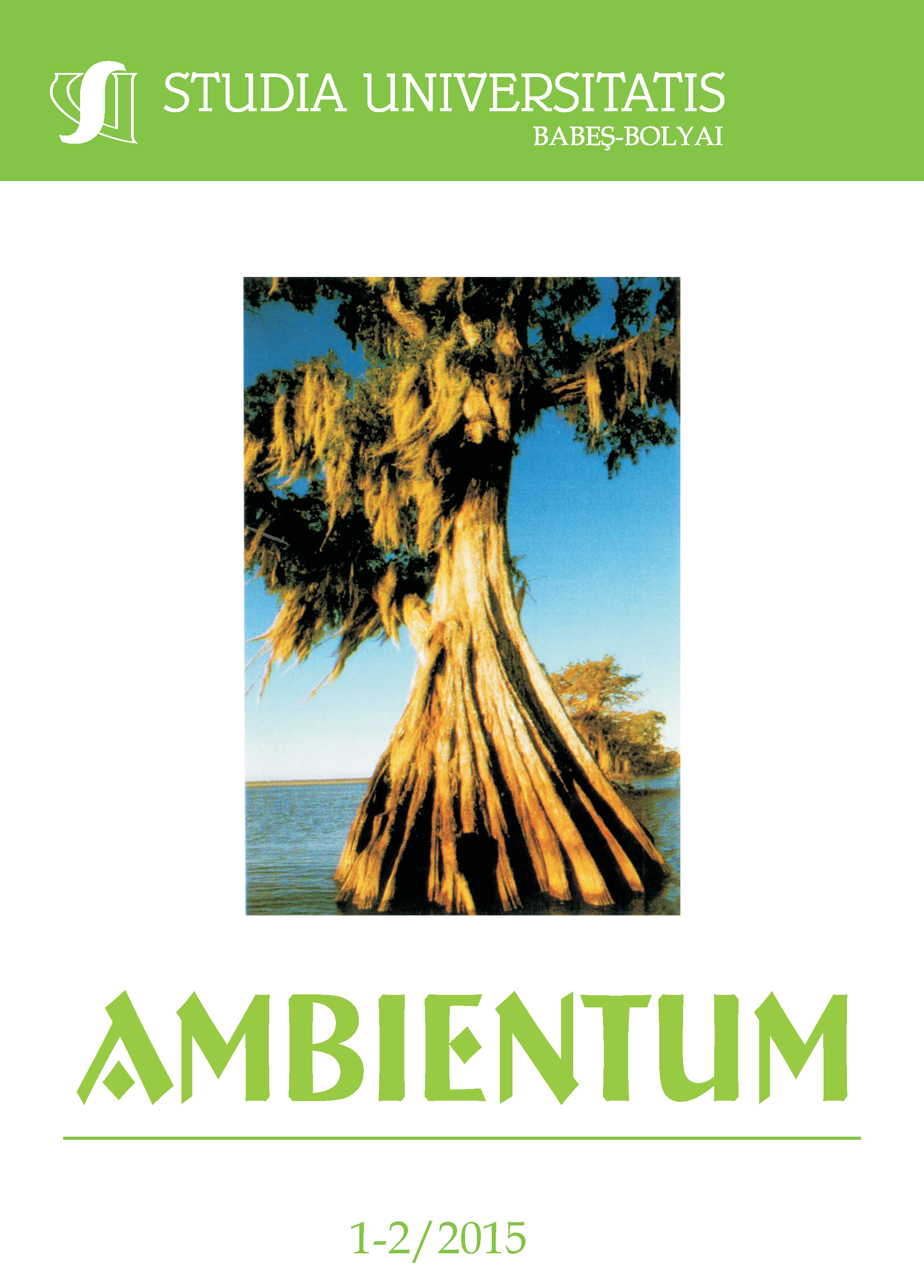HIGHLIGHTING THE MAJOR HYDROLOGICAL EVENTS USING ²¹⁰PB RADIOMETRIC METHOD IN VALEA VINŢULUI RIVER
Keywords:
sedimentation rate, ²¹⁰Pb dating method, alpha spectrometry, CRS modelAbstract
The growing interest in the dynamics of floodplains and the important role of alluvial sedimentation in river meadows, which acts as an archive of sediment, have focused on the need to document contemporary and recent sedimentation rates. This paper presents the results obtained of highlighting the major hydrological phenomena for Valea Vinţului and Pian river meadows, located in the Mureş river basin, characterized as high-risk flood areas. For the first time in Romania, ²¹⁰Pb radiometric method was used to obtain first estimates of sedimentation rate in a floodplain (Valea Vinţului river). After chemical preparation (acid leaching) of alpha spectrometric sources, ²¹⁰Pb concentrations in the samples were determined by measuring its daughter isotope ²¹⁰Po using the alpha spectrometer ORTEC Soloist, equipped with a PIPS detector with 900 mm2 active surface for recording of alpha particles 5,3 MeV ²¹⁰Po. Activities from 23±5 to 94±6 Bq/kg ²¹⁰Pb were found for Valea Vinţului river floodplain. After applying the CRS model (Constant Rate of ²¹⁰Pb Supply), the results of this method were compared with reports from literature and from the Water Management System Alba and there were observed periods of massive deposits due to floodings between years 1936 and 2012 (± 2 years) with a alluvial sedimentation rate of 1.863 ± 0.167 up to 6.185 ± 1 g/cm2*y.
References
Appleby, P., Oldfield, F., 1978, The calculation of lead-210 dates assuming a constant rate of supply of unsupported 210Pb to the sediments. Catena 5, pp. 1-8.
Appleby, P. 2001, Chronostratigraphic techniques in recent sediments. In W. Last, J. Smol (Eds), Tracking Environmental Change Using Lake Sediments. Volume I: Basin Analysis, Coring, and Chronological Techniques, 171-203. Dordrecht: Kluwer Academic Publishers.
Begy, R.C., Cosma, C., Horvath, Z. 2008, Sediment accumulation rate in the Red Lake (Romania) determined by Pb-210 and Cs-137 radioisotopes. Earth and Environmental Physics, pp. 943-949.
Begy, R.C., Cosma, C., Timar, A. 2009, Recent changes in Red Lake (Romania) sedimentation rate determined from depth profiles of 210Pb and 137Cs radioisotopes. Journal of Environmental Radioactivity 100 (8), pp. 644-648.
Begy, R.C., Timar-Gabor, A., Somlai, J., Cosma, C. 2011, A sedimentation study of St. Ana Lake (Romania) applying the 210Pb and 137Cs dating methods. Geochronometria, pp. 93-100.
Birch, G., Olmos, M., Lu, X. 2012, Assessment of future anthropogenic change and associated benthic risk in coastal environments using sedimentary metal indicators. Journal of Environmental Management 107, pp. 64-75.
Du, P., Walling, D. 2012, Using 210Pb measurements to estimate sedimentation rates on river floodplains. Journal of Environmental Radioactivity 103, pp. 59-75.
Edgington, D.N., Robbins, J.A. 1975, Determination of the activity of Lead-210 in sediments and soils.
Humphries, M.S., Kindness, A., Ellery, W.N., Hughes, J.C., Benitez-Nelson, C.R. 2010, 137Cs and 210Pb derived sediment accumulation rates and their role in the long-term development of the Mkuze River floodplain, South Africa. Geomorphology 119, pp. 88-96.
Kiss, T., Oroszi, V.G., Sipos, G., Fiala, K., Benyhe, B. 2011, Accelerated overbank accumulation after nineteenth century river regulation works: A case study on the Maros River, Hungary. Geomorphology 135, pp. 191–202.
Masque, P., Isla, E., Sanchez-Cabeza, J., Palanques, A., Bruach, J., Puig, P., Guillen, J. 2002, Sediment accumulation rates and carbon fluxes to bottom sediment at the Western Bransfield Strait (Antarctica). Deep-Sea Research II 49, pp. 921-933.
Mustăţea, A. 2005, Viituri excepţionale pe teritoriul României. Geneză şi efecte. Bucureşti: Tipografia SC ONESTA.COM PROD 94 SRL.
Oldfield, F., Appleby, P. 1984, Empirical testing of 210Pb-dating models for lake sediments. In: Hayworth EY and Lund JWG (Eds). Lake Sediments and Environmental History. Leicester University Press, pp. 93-124.
Robbins, J. 1978, Geochemical and geophysical applications of radioactive lead. Biogeochemistry of Lead in the Environment, pp. 285–393. Amsterdam: Elsevier Scientific.
Sanchez-Cabeza, J., Ruiz-Fernandez, A. 2012, 210Pb sediment radiochronology: An integrated formulation and classification of dating models. Geochimica et Cosmochimica Acta 82, pp. 183–200.
Sert, I., Yener, G., Ozel, E., Pekcetinoz, B., Eftelioglu, M., Gorgun, A. U. (2012). Estimation of sediment accumulation rates using naturally occuring 210Pb models in Gülbahçe Bay, Aegean Sea, Turkey. Journal of Environmental Radioactivity 107, 1-12.
Szmytkiewicz, A., Zalewska, T. 2014, Sediment deposition and accumulation rates determined by sediment trap and 210Pb isotope methods in the Outer Puck Bay (Baltic Sea). Oceanologia, 56, pp. 85-106.
Tylmann, W. 2004, Estimating recent sedimentation rates using Pb-210 on the example of morphologically complex lake ( Upper lake Radunskie, N Poland). Geochronom 23, pp. 21-26.
Downloads
Published
How to Cite
Issue
Section
License
Copyright (c) 2015 Studia Universitatis Babeș-Bolyai Ambientum

This work is licensed under a Creative Commons Attribution-NonCommercial-NoDerivatives 4.0 International License.





 ISSN (online): 2065-9490 | ISSN (print): 1843-3855 | ISSN-L: 2065-9490
ISSN (online): 2065-9490 | ISSN (print): 1843-3855 | ISSN-L: 2065-9490